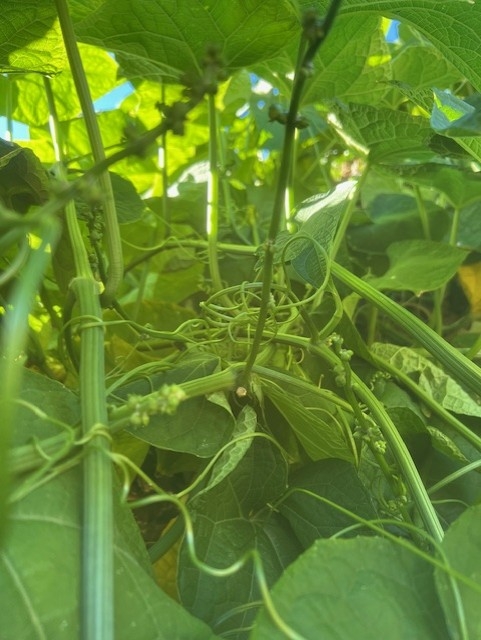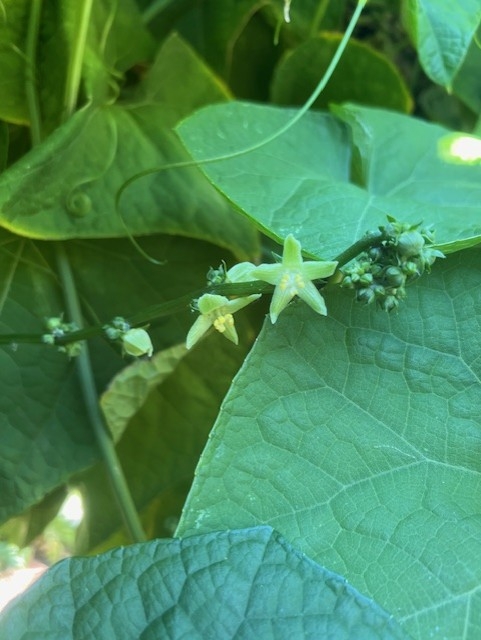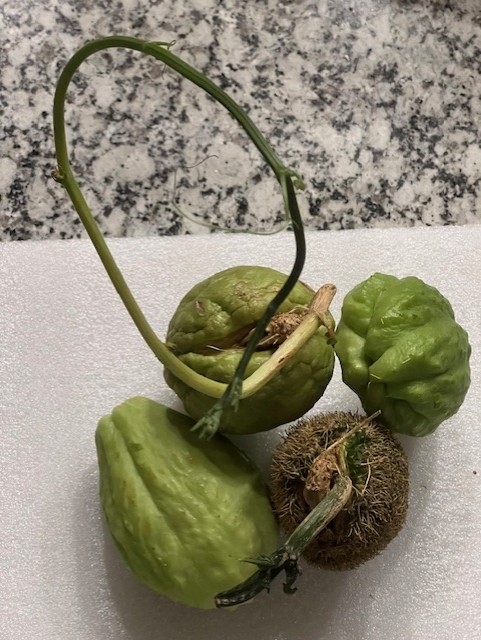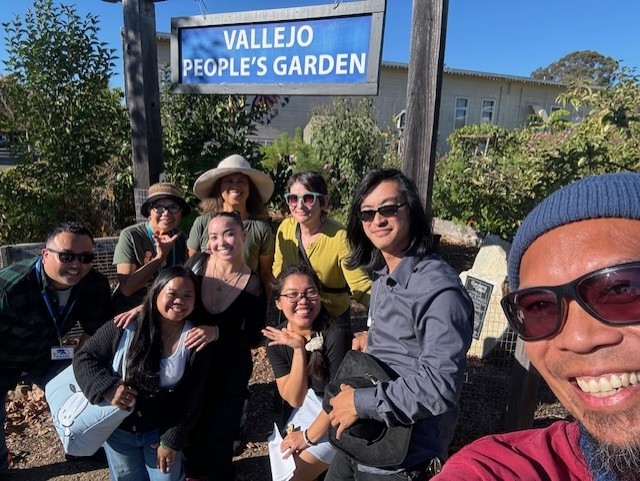UC Gardening Blogs
Entomologist Jeff Smith: The Master Builder of Insect Specimen Drawers
When you slide open the butterfly and moth drawers at the Bohart Museum of Entomology, UC...

Jeff Smith, curator of the Lepidoptera collection at the Bohart Museum, stands by the drawers he crafted. (Photo by Kathy Keatley Garvey)

The Bohart Museum drawers are intricately crafted. This one is of pine. Curator Jeff Smith has crafted and donated 2,487 of them for the Bohart Museum of Entomology. (Photo by Kathy Keatley Garvey)

Close-up of a drawer in the Lepidoptera collection, Bohart Museum of Entomology. (Photo by Kathy Keatley Garvey)
Filipino Cultural Vegetables at the Vallejo People's Garden
Filipino-American History Month (FAHM) is a yearly event in October to commemorate the arrival of the first Filipinos in the continental United States at what is now Morro Bay, California on October 18, 1587.
On October 15, we celebrated Fil-Am History Month at the Vallejo Peoples Garden (VPG) by doing a presentation on Filipino cultural vegetables. A group of Filipino-American students and faculty from Solano Community College attended the event.
I presented two vegetables extensively cultivated in the Philippines and grown at VPG on Mare Island:
CHAYOTE
Chayote is a perennial vegetable vine that grows abundantly in the Philippines. Here in Solano County, chayote is a perennial vegetable and often grown as an annual.
The chayote fruit comes mostly in green or yellow green smooth skin; or dark green color with sharp spines on the skin. (Ouch on the latter so be careful when handling)! We planted our first organic chayote vine at VPG with the green/yellow skin three years ago and are now growing the dark green spiney chayote since last year.
The chayote fruit is irregularly oval-shaped and grooved. The large edible seed is surrounded by meaty flesh. A prolific vine grower, one plant can produce 60-80 palm-sized fruits. Our harvest last year yielded more than that I believe.
HOW TO GROW CHAYOTE
• Look for an older fruit with tough skin. Buy organic chayote if available at your local grocery.
• Leave the fruit on the kitchen counter until the sprout emerges. Chayote seed sprout will germinate only inside the fruit.
• Plant the whole fruit in a pot with the tip of new growth just peeping out of the soil.
• Leave the chayote in the pot until the last frost danger is past (late March/early April).
• Set the fruit in the ground edgewise and slanted.
• Plant the vine in rich, well-drained soil next to a sturdy fence or trellis where it will climb by tendrils.
• Some literature says two plants are required for cross-fertilization. Others say, “Bury lone fruit, produce an epic plant.” At VPG, we only planted one fruit.
• Chayote requires full sun and deep watering at least once a week. Mulch around the vine for moisture retention.
• Chayote is a long-season growing plant; the vine can grow 30 ft. or more before it starts blooming.
• Sprays of green blossoms will appear when the days begin to shorten.
• Chayote fruiting can begin in October until the earliest frost.
• At the Vallejo Peoples Garden we cut back the vine close to the ground after fruiting leaving only a few good stalks. We mulch heavily around the plant to conserve moisture. Where the ground freezes, the root tubers can be dug up and stored for replanting in the springtime.
CULINARY USES OF CHAYOTE
All parts of the chayote vine are edible: from the root tubers to the tender tips of the vines.
. Chayote has a subtle taste; it is adaptable to the flavor of other ingredients like tofu.
• It is used in Indian chutneys, Asian stir-fries, French quiches and New Orleans pies.
• Chayote can be used as a substitute for squash, cucumbers and potatoes.
• It can be pickled or eaten raw in salads.
• Mexicans steam the fruit, dip it in salsa, or use it in stews.
• I stir-fry chayote with shrimp, tomatoes, and mushrooms.
I also use it as an ingredient for making pancit (noodles) and chicken soups.
Truly, chayote is a versatile vegetable and you can expect a bumper harvest from only one plant!
I will cover the next cultural vegetable on my next blog.
Meanwhile, happy chayote planting!

Chayote plant. photos by Elvie Deleon

Chayote flowers.

Chayote fruit.

VPG students. photographer unknown
Spotted Lanternfly: The Need to Remain Vigilant (Part 1)
On March 27th, 2024, a flatbed truck carrying a metal art structure originating in New York and headed to Petaluma, California was stopped at the California Department of Food and Agriculture (CDFA) Agricultural Inspection Station in Truckee, California due to live spotted lanternfly (SLF) egg masses being present on the structure (Fig. 1).
Entry of the structure was denied, and the truck reported to the Nevada Department of Agriculture for inspection and treatment for SLF eggs on April 2, 2024. Approximately 30 egg masses were removed and destroyed (Fig. 2). The structure was power washed with soap and water and cleared to enter California with instructions to not offload the structure at the destination until inspected and released by the Sonoma County Department of Agriculture/Weights & Measures.
Upon arrival for inspection, the Sonoma County agricultural inspector found the structure already offloaded from the truck and during an in-depth inspection of the structure, three more SLF egg masses were discovered. Additional inspectors were called in, and with the help of operators and equipment at the destination site, the agricultural inspectors were able to inspect all surface areas and ensure the structure was free of SLF egg masses.
To put this into perspective, spotted lanternfly egg masses contain 30 to 50 eggs each, meaning that this structure had between 990 to 1,650 live SLF eggs arriving approximately a month prior to the expected hatching time.
In July of 2021, the CDFA established a quarantine to prohibit the introduction of the spotted lanternfly (Lycorma delicatula) into California (Release #21-077). The quarantine prohibits the entry into California of SLF, its host plants and plant parts (including firewood), shipping containers, and a variety of articles, including outdoor household articles and conveyances (cars, boats, trailers, tractors, etc.) originating from any area where an SLF infestation exists without proper documentation.
Nymphs cannot fly and adults do not readily fly away when approached so both can be easily collected. Early detection is key for preventing the establishment of this species. Californians need to remain vigilant and together, we can all play a role in keeping the spotted lanternfly out of California.
Adapted from an article by Cindy Kron, Ph.D published in CAPCA's magazine, "The Advisor" published August 2024.

CDFA Snag it Snap it Report it
Franco: Deciphering Soil Macrobiome and Ecosystem Responses to Global Change
It promises to be an outstanding seminar. André Custodio Franco, assistant professor,...

What's up with soil and global change? Andre Franco of Indiana University will speak on "Deciphering the Soil Macrobiome: Belowground Communities Driving Ecosystem Responses to Global Change" at 4:10 p.m., Monday, Nov. 18 in 122 Briggs Hall. It also will be on Zoom and then archived. (Photo by Kathy Keatley Garvey)
CAMBP Classes on Pollinator Gardens and Apiary Technology
Like to learn about planning a year-round native pollinator garden or about technology in the...

Honey bee nectaring on tower of jewels, Echium wilpretii. This is a non-native, but isn't it pretty? The California Master Beekeeper Program is offering a class on "Planning Year-Round Native Plant Pollinator Garden" on Nov. 17. (Photo by Kathy Keatley Garvey)

A class on "Technology in the Apiary" will be offered Dec. 7 by the California Master Beekeeper Program. (Photo courtesy of the California Master Beekeeper Program)





